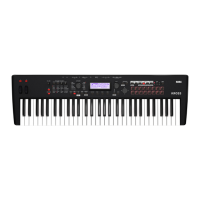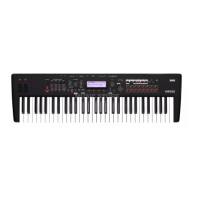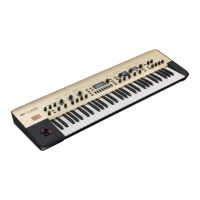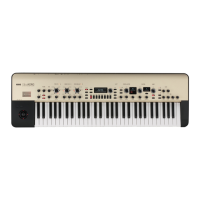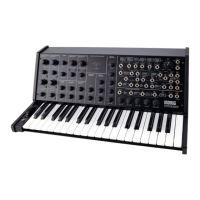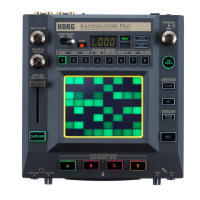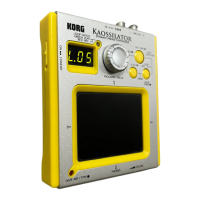Playing and editing Combinations
46
Creating Splits and Layers
Splits and Layers
Let’s create a Combination that combines both splits and
layers, like the diagram below:
1. Access the COMBI> PROG page.
2. Select a piano sound for Timbre 1, a brass sound for
Timbre 2, and a string sound for Timbre 3.
3. For timbres 1–3, set Status to INT.
4. Access the C-TIMBRE MIDI page.
5. For timbres 1–3, set the MIDI Channel to Gch (Global
channel).
6. Access the C-ZONE/DELAY> KEY ZONE page.
7. For timbre 1, set “Top Key” to G9 and Bottom Key to
C4.
You can also enter a note value by moving the cursor to
the parameter in the display, then holding down the
ENTER button and pressing a note on the keyboard.
8. For timbre 2 and timbre 3, set the Top Key to B3 and
the Bottom Key to C-1.
Key Zone Slope
In addition to “hard” splits, where the sound changes
abruptly, you can use the Slope parameters to gradually fade
a sound in or out over a range of keys.
We’ll make some changes to the example shown above.
1. In the example above, you could set the Bottom Key of
timbre 1 to G3, and set the Top Key of timbre 2 to G4,
so that these two timbres overlap.
2. Next, if you set the Bottom Slope of timbre 1 to 12, and
set the Top Slope of timbre 2 to 12, the sound will
change gradually instead of changing suddenly.
Creating Velocity Switches
Next, let’s create a simple velocity switched Combination,
like the diagram below:
1. Access the COMBI> PROG page.
2. Select a brass sound for Timbre 1, and a string sound
for Timbre 2.
3. For timbres 1 and 2, set the Status to INT.
4. Access the C-TIMBRE MIDI page.
5. For timbres 1 and 2, set the MIDI Channel to Gch
(Global MIDI channel).
6. Access the C-ZONE/DELAY> VEL ZONE page.
7. For timbre 1, set the Top Velocity to 127 and the
Bottom Velocity to 64.
You can also enter a velocity value by moving the cursor
to the parameter in the display, then holding down the
ENTER button and playing a note on the keyboard.
8. For timbre 2, set the Top Velocity to 63 and Bottom
Velocity to 1.
Velocity Zone Slope
Similar to Key Zone Slopes, as described above, these let
you fade sounds in and out gradually over a velocity range,
instead of a simple hard switch.
We’ll make some changes to the example shown above.
1. Set the velocity zones of the two timbres so that they
partially overlap.
2. Set the Top Slope and Bottom Slope so that the sound
changes gradually, rather than abruptly between
velocity values 63 and 64.
C–1 C4 G9B3
PianoTimbre 1
Brass
Timbre 2
Strings
Timbre 3
127
64
63
1
Strings
Velocity
switch
Timbre 1
Timbre 2
Brass
